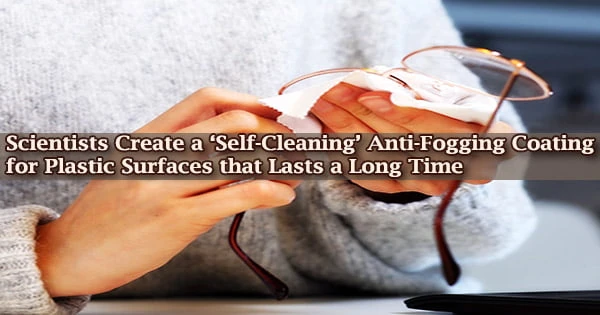Scientists at Nanyang Technological University in Singapore (NTU Singapore) have invented a novel form of coating that resists fogging and ‘self-cleans’ when applied to a plastic surface, eliminating the need for repeated reapplications. A two-step process is used to coat a thin double-layered silicon dioxide titanium dioxide film with a durable coating.
The plastic surface is first cleaned using oxygen plasma, which is a popular industrial procedure for improving adhesion. The thin double-layered film is then placed on the plastic surface using pulse laser deposition, which involves focusing a laser beam to vaporize material from the chosen coating targets in order to obtain the appropriate film thickness.
When compared to similar industrial procedures, the approach allows for better control of the film’s thickness and structure throughout creation, resulting in a higher-quality film.
The coating adhered to the plastic surface quite well. The coating retained good durability when subjected to abrasion with a cheese cloth pad, a standard test for optical coating, and an adhesion test with cellophane tapes.
When water vapour condenses as water droplets on a surface, fogging occurs, and the anti-fogging performance of a coating is determined by the rate at which the condensed water droplets spread into a uniform layer that does not obscure visibility.
Digital fast frame photography investigations on the new coating revealed a water droplet spreading in 93 milliseconds, less than the average human eye blink time of 100 milliseconds.
The reported results prove the multifunctionality of our coating. It is antireflective, antifogging, and self-cleaning. Additionally, the fabrication approach is fast and easy to implement with great durability. This makes our innovation unique among other antifogging methods which tend to end up with coatings with limited functions.
Sun Ye
In December 2021, the NTU team’s findings were published in the peer-reviewed scientific journal Applied Surface Science.
Overcomes limitations of temporary anti-fogging coatings
Anti-fogging sprays and wipes have been increasingly popular among spectacle and eyeglass wearers, particularly during the COVID-19 pandemic, when mask wear has become the norm and wearers desire to avoid condensation obstructing their vision.
Solar panels, windshields, displays, and lenses used in humid settings all include anti-fogging coatings.
Anti-fogging sprays and wipes, for example, are only temporary because they cannot withstand washing and must be reapplied on a frequent basis. Furthermore, they are susceptible to surface contamination by dirt or germs, necessitating replacement or maintenance.
While anti-fogging coatings for plastics have been created elsewhere, two of the most significant challenges to their general use are the long manufacturing time and poor durability, or the lack of adhesion between the plastic surface and the coating.
Co-principal investigator of the study, Professor Chen Zhong of the NTU School of Materials Science and Engineering (MSE) said, “Most anti-fogging solutions today are temporary and have limited efficacy. Our team has demonstrated an approach that is fast to fabricate, taking around an hour, and produces long-lasting results, proving its potential for wide-ranging practical applications.”
The NTU research team believes their creation offers an attractive, long-term solution to solve challenges of plastic fogging that may also cut expenses and waste due to the newly created coating’s long-lasting anti-fogging and ‘self-cleaning’ capacity.
Coating ‘self-cleans’ under sunlight exposure
Titanium dioxide, a material employed in the NTU team’s coating, has photocatalytic properties, which means it can ‘self-clean’ by interacting with and eliminating organic residues when exposed to sunshine (ultraviolet light).
The newly created coating was able to break down contaminants (i.e., germs, dirt) on the plastic surface after a full day of UV light exposure in lab testing, demonstrating its ‘self-cleaning’ capabilities.
Co-lead researcher, Professor Rajdeep Singh Rawat, Head, Natural Sciences & Science Education Academic Group at the National Institute of Education, NTU, said, “Our innovation is promising for use in industrial applications of various optical components, for example, on surveillance camera protective covers. The ability for the coating to ‘self-clean’ makes it a low-maintenance and trouble-free solution since the cover may be less obscured by surface dirt and grime, providing a clearer view for surveillance.”
The new anti-reflective coating has a visible light transmittance of up to 89 percent on a normal plastic lens, which is around 5% higher than the same lens without a coating. This is especially advantageous in eyeglasses, as higher visible light transmittance allows more light to pass through the plastic and reach the eye, resulting in improved clarity.
First author of the study Sun Ye, a PhD student at the School of MSE, said, “The reported results prove the multifunctionality of our coating. It is antireflective, antifogging, and self-cleaning. Additionally, the fabrication approach is fast and easy to implement with great durability. This makes our innovation unique among other antifogging methods which tend to end up with coatings with limited functions.”
The research team has filed a Singapore patent for the invention, and they are searching for industrial partners to help them move it from the lab to the market.





